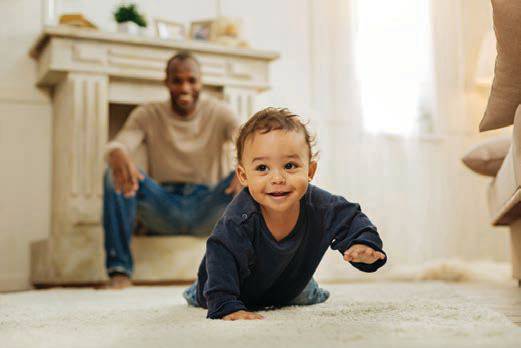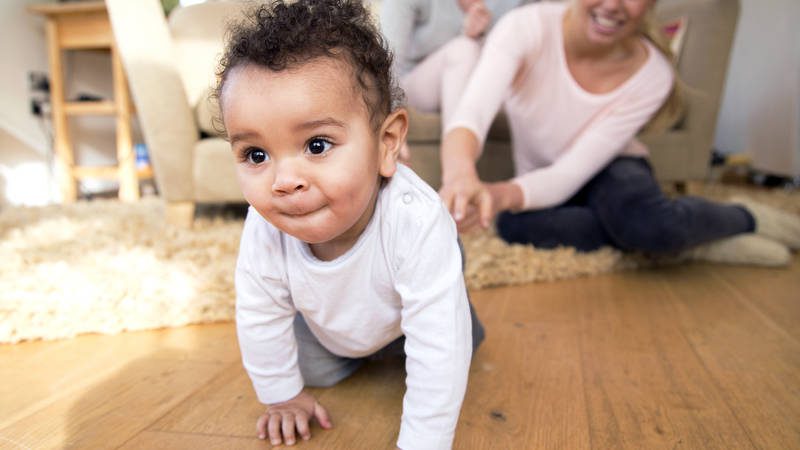The process of learning to crawl is actually pretty complex. Try these tips to support babies as they explore movement through crawling.
When do babies start crawling?
Are you wondering when do babies start crawling? The answer is that most babies begin to really start moving in the second half of their first year. At first they may get up on all fours and rock back and forth—like a rocket at countdown, waiting to take off. But unlike a rocket ship, little ones might stay in “countdown” mode for a weeks before they are ready to start moving. The process of learning to crawl is actually pretty complex. Babies need to coordinate the movement of their arms and legs, and develop the muscle strength in their arms, shoulders, and legs to support their weight.
How Babies Learn to Crawl
A baby’s first jump forward might actually be a scoot backward. As babies figure out how to do that arm-leg-arm-leg crawling movement, they sometimes go backward first, and then learn how to crawl forward. So, for a while, babies might cry in frustration as they somehow find themselves scooting away from the very object or person they are so determined to reach.
The process of learning to crawl differs among babies as they work out a way to move that is unique to them.
Some crawling styles and ways babies learn to move:
- The “I’ll Have the Usual”
This is the classic crawl on hands and knees—alternating hand on one side and knee on the other to go, go, go. - The “Crab”
Just like at the beach, the “crab” bends one knee and extends the opposite leg to scoot forward. - The “Commando”
Look out, this crawler lies flat on her belly and drags herself forward using her arms similar to a bear crawl. - The “Rolling Wonder”
Who needs to crawl when rolling gets me where I need to go? - The “Take It in Stride” Kid
Some children skip crawling and go right to walking. No time to waste—here I come!
As long as a baby is making progress in their ability to use their body to get around, that’s what’s important.
How to Help a Baby Learn to Crawl

The process of learning to crawl differs among babies as they work out a way to move that is unique to them.
Here are a few ways to help teach a baby to crawl:
- Give your baby plenty of tummy time, starting from birth. By playing on their bellies, babies develop the muscle strength in their shoulders, arms, back and trunk (torso) that helps them learn to crawl.
- Encourage your baby to reach for the toys she is interested in. Lay interesting toys at just a short distance from your almost-crawler. See if she is able to move herself toward these objects.
- Make sure your baby has space to explore that is safe and supervised. Now is the time to begin child-proofing your home. Take a walk through (or better yet, a crawl-through) your home and see what potential hazards may be at your baby’s level.
- Place the palms of your hands behind your child’s feet when he is on all fours. This stabilizes him and gives him something to “push off” from when he is just learning to crawl.
What to Avoid
- Baby walkers.
Not only are they potentially dangerous, they limit practice time on the floor learning to crawl. Walkers can also hamper muscle development. - Spending lots of time in baby seats and baby carriers.
Babies learn how to crawl, and later pull up to stand and then walk, when they have plenty of time each day to play, move, and explore. - Pushing your child to learn to crawl.
Pressing a child to develop a skill he isn’t ready for can actually slow the learning process.
When Should I Worry?
Like most developmental milestones, crawling starts at any point across a fairly long range—anywhere from 5 to 13 months of age, with half of all babies starting to crawl at about 8 months of age. (And, about 7% of babies skip crawling altogether!) Also, if a child is a bit bigger or heavier than is typical for his age, he may crawl later as it is more challenging for babies to push up onto all fours and move their extra body weight. Babies who were born prematurely may also crawl later.
In most cases, there is nothing physically wrong with babies who are slow to crawl. They may just be busy working on other skills that are more interesting to them, like learning to use their hands to figure out how objects work. They may prefer to sit and explore the world visually or by touch (with their hands), instead of exploring through movement. Remember, babies, like adults, have different preferences and interests.
Contact your child’s health care provider if:
- You notice that your child is using only one side of her body to crawl (she pushes off with only one arm or drags one side of her body as she scoots across the floor); or
- Your baby is not making forward progress in using her body to get around.
How to Child-Proof Your Home for Crawling
Learning to crawl means it’s time to child-proof your home!
Now that your baby is crawling, she will soon be pulling up as she prepares to walk. This means she will be able to get her hands on objects that had previously been unreachable and are potentially dangerous.
And remember, even though babies are moving around fairly well on their own, they still aren’t able to follow rules about what to touch or not to touch. So it is very important to make sure your home is child-proofed so that your baby has a safe place to play and explore.
Take a walk through (or better yet, a crawl-through) your home and see what potential hazards may be at your baby’s level.
Some obvious things to take notice of:
- Electrical outlets
- Electrical cords
- Baby gates on all stairs—top and bottom
- Toilet seat locks
- Plant stands (as well as other “tippy” tables)
- Houseplants within baby’s reach
- Poisonous home cleaning supplies within baby’s reach
- Sharp corners on coffee tables and end tables
- Fragile knick-knacks that can be grabbed or knocked over
- Dressers, bookshelves, television stands, etc. that can be tipped over. When babies start to “cruise” they will often pull up on these items and should be secured to the wall with an anti-tip bracket.
By making your baby’s environment as safe as possible, you are creating the perfect space to support her growing skills and healthy development.


